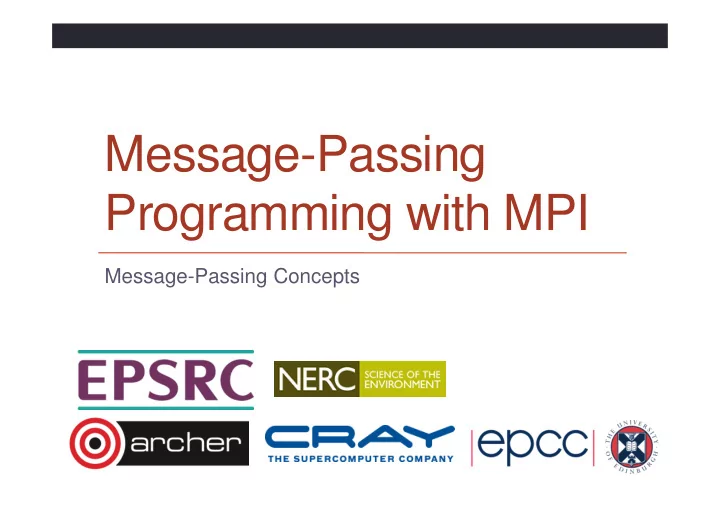

Message-Passing Programming with MPI Message-Passing Concepts
Overview • This lecture will cover • message passing model • SPMD • communication modes • collective communications
Programming Models Message-Passing Serial Programming Parallel Programming Concepts Concepts Arrays Processes Subroutines Groups Send/Receive Control flow Variables Collectives SPMD Human-readable OO Libraries Languages C/C++ Java MPI Python Fortran MPI_Init() struct if/then/else Implementations Implementations MPICH2 gcc -O3 icc pgcc -fast Cray MPI Intel MPI crayftn craycc IBM MPI OpenMPI javac
Message Passing Model • The message passing model is based on the notion of processes • can think of a process as an instance of a running program, together with the program’s data • In the message passing model, parallelism is achieved by having many processes co-operate on the same task • Each process has access only to its own data • ie all variables are private • Processes communicate with each other by sending and receiving messages • typically library calls from a conventional sequential language
Sequential Paradigm ������� ������� ������� ������� ������ ������ ������ ������ � � � � ��������� ��������� ��������� ��������� � � � �
Parallel Paradigm ��������� ��������� ��������� ��������� 1 2 3 0 ������������������������� ������������������������� ������������������������� ������������������������� ��������������������� ��������������������� ��������������������� ���������������������
Distributed-Memory Architectures P M P M P M P M P M Interconnect P M P M P M
Process Communication Process 1 Process 2 Recv(1,b) a=23 Program a=b+1 Send(2,a) 23 24 Data 23 23
SPMD • Most message passing programs use the Single- Program-Multiple-Data (SPMD) model • All processes run (their own copy of) the same program • Each process has a separate copy of the data • To make this useful, each process has a unique identifier • Processes can follow different control paths through the program, depending on their process ID • Usually run one process per processor / core
Emulating General Message Passing (C) main (int argc, char **argv) { if (controller_process) { Controller( /* Arguments */ ); } else { Worker ( /* Arguments */ ); } }
Emulating General Message Passing (F) PROGRAM SPMD IF (controller_process) THEN CALL CONTROLLER ( ! Arguments ! ) ELSE CALL WORKER ( ! Arguments ! ) ENDIF END PROGRAM SPMD
Messages • A message transfers a number of data items of a certain type from the memory of one process to the memory of another process • A message typically contains • the ID of the sending process • the ID of the receiving process • the type of the data items • the number of data items • the data itself • a message type identifier
Communication modes • Sending a message can either be synchronous or asynchronous • A synchronous send is not completed until the message has started to be received • An asynchronous send completes as soon as the message has gone • Receives are usually synchronous - the receiving process must wait until the message arrives
Synchronous send • Analogy with faxing a letter. • Know when letter has started to be received.
Asynchronous send • Analogy with posting a letter. • Only know when letter has been posted, not when it has been received.
Point-to-Point Communications • We have considered two processes • one sender • one receiver • This is called point-to-point communication • simplest form of message passing • relies on matching send and receive • Close analogy to sending personal emails
Collective Communications • A simple message communicates between two processes • There are many instances where communication between groups of processes is required • Can be built from simple messages, but often implemented separately, for efficiency
Barrier: global synchronisation ������� ������� ������� ������� ������� ������� ������� ������� ������� ������� ������� �������
Broadcast: one to all communication
Broadcast • From one process to all others 8 8 8 8 8 8
Scatter • Information scattered to many processes 1 2 0 0 1 2 3 4 5 4 3 5
Gather • Information gathered onto one process 1 2 0 0 1 2 3 4 5 4 3 5
Reduction Operations • Combine data from several processes to form a single result ������� ������� ������� �������
Reduction • Form a global sum, product, max, min, etc. 1 2 0 15 4 3 5
Launching a Message-Passing Program • Write a single piece of source code • with calls to message-passing functions such as send / receive • Compile with a standard compiler and link to a message- passing library provided for you • both open-source and vendor-supplied libraries exist • Run multiple copies of same executable on parallel machine • each copy is a separate process • each has its own private data completely distinct from others • each copy can be at a completely different line in the program • Running is usually done via a launcher program • “please run N copies of my executable called program.exe ”
Issues • Sends and receives must match • danger of deadlock • program will stall (forever!) • Possible to write very complicated programs, but … • most scientific codes have a simple structure • often results in simple communications patterns • Use collective communications where possible • may be implemented in efficient ways
Summary (i) • Messages are the only form of communication • all communication is therefore explicit • Most systems use the SPMD model • all processes run exactly the same code • each has a unique ID • processes can take different branches in the same codes • Basic communications form is point-to-point • collective communications implement more complicated patterns that often occur in many codes
Summary (ii) • Message-Passing is a programming model • that is implemented by MPI • the Message-Passing Interface is a library of function/subroutine calls • Essential to understand the basic concepts • private variables • explicit communications • SPMD • Major difficulty is understanding the Message-Passing model • a very different model to sequential programming if (x < 0) print(“Error”); exit;
Recommend
More recommend